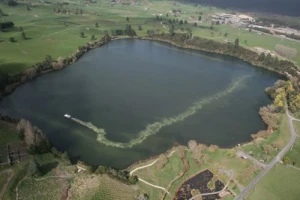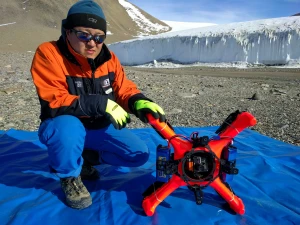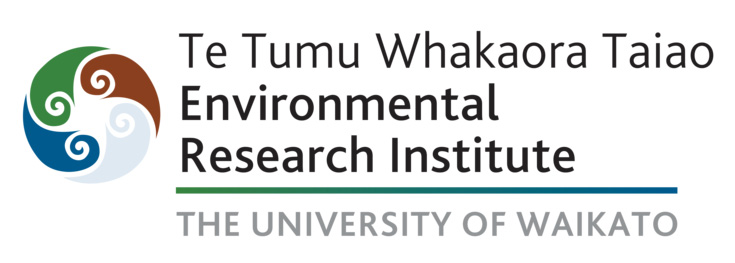Predictions are that if we continue on current path, we will run-out of resources in the near future, and our environment will change in such a way that a large part of the global population will experience significant decline in their well-being, including displacement, poverty, and insecure food supply. Technological advances will help us change our pathway and reduce some of the severest impacts. Here we present some highlights from our activities over the last few years.
Ecosystem modelling platform to assist New Zealand lake management
Contact: Dr Deniz Özkundakci
 New Zealand lakes are under increasing pressure from land use intensification, urbanisation, and invasive species proliferation. Lake ecosystem models express scientific knowledge of biological and physical lake processes forced by weather and climate into computer-coded equations. Model simulations can explain present day ecosystem states and predict future trajectories, and help to set aspirational water quality goals. This makes models a powerful tool to assess, manage, and protect NZ’s essential freshwater resources. They help us make management decisions such as selecting appropriate and effective actions to achieve desired outcomes.
New Zealand lakes are under increasing pressure from land use intensification, urbanisation, and invasive species proliferation. Lake ecosystem models express scientific knowledge of biological and physical lake processes forced by weather and climate into computer-coded equations. Model simulations can explain present day ecosystem states and predict future trajectories, and help to set aspirational water quality goals. This makes models a powerful tool to assess, manage, and protect NZ’s essential freshwater resources. They help us make management decisions such as selecting appropriate and effective actions to achieve desired outcomes.
But ecosystem models currently require expert knowledge to set up and parameterise, making them inaccessible for most practitioners. Our Smart Idea involves the use of advanced computing technologies (including supercomputing) and software to generate models for all New Zealand lakes based on knowledge gained from automated models generated for 100 lakes with known water quality. Our research will enable better management of lakes by providing councils and iwi the tools needed to simulate pathways to aspirational water quality targets.
New Zealand is a perfect place for the development of such a platform for our country boasts a diverse range of lakes, good observational records and comprehensive open geospatial data sets. However, our approach is developed with international export in mind. To ensure cutting edge science and global relevance, we connect to awesome national and international colleagues. Susie Wood (Cawthron Institute) and Marcus Vandergoes (GNS Science) will help scaling up modelling to all NZ lakes through linkages with the national-scale MBIE project ‘Lakes380’. David Hamilton (Griffith University, Australia), Dennis Trolle (Aarhus University), Annette Janssen (Wageningen University), Liancong Luo (Chinese Academy of Sciences) and Kevin Rose (Rensselaer Polytechnic Institute) form an international advisory group of world leaders in the fields of lake ecosystem models and remote sensing, ensuring global relevance, and connectedness of the research.
Using the hyperspectral camera in Antarctica
Contact: Dr Charles Lee
 Instead of vascular plants, the unique terrestrial ecosystems of Antarctica are supported by an assortment of bryophytes, algae, and photosynthetic microbial mats. Of these, microbial mats dominated by Cyanobacteria are the most important source of organic carbon and nitrogen, yet there is limited understanding of how environmental factors determine their ecology and physiological state.
Instead of vascular plants, the unique terrestrial ecosystems of Antarctica are supported by an assortment of bryophytes, algae, and photosynthetic microbial mats. Of these, microbial mats dominated by Cyanobacteria are the most important source of organic carbon and nitrogen, yet there is limited understanding of how environmental factors determine their ecology and physiological state.
Utilising near-ground remote-sensing techniques, including an airborne hyperspectral imager, Charlie and his team has developed a method to precisely map the distribution and physiological state of various types of microbial mats in the McMurdo Dry Valleys. This provides a framework to understand how climate-driven increase in meltwater will affect Antarctic cyanobacterial mats, and the overall productivity of terrestrial Antarctic ecosystems.
This work supports New Zealand’s commitment to understand and protect Antarctic environments and has developed novel techniques that are directly transferable to more complex biological systems in New Zealand and elsewhere.
Automated monitoring of our coast
Contact: Dr Julia Mullarney
 Our coastlines are ever-changing dynamic regions, which offer a challenge to scientists and managers trying to obtain reliable measurements of key environmental variables. However, such good quality measurements are necessary to underpin and develop robust coastal monitoring and protection strategies. Luckily, new technologies (both measurement techniques and instrumentation) are currently being developed to overcome some of the main difficulties and to provide opportunities to widen the scope of data collection.
Our coastlines are ever-changing dynamic regions, which offer a challenge to scientists and managers trying to obtain reliable measurements of key environmental variables. However, such good quality measurements are necessary to underpin and develop robust coastal monitoring and protection strategies. Luckily, new technologies (both measurement techniques and instrumentation) are currently being developed to overcome some of the main difficulties and to provide opportunities to widen the scope of data collection.
Masters of Science research student Morgan Harvie,technician Dean Sandwell, and supervisor Dr Julia Mullarney, have been exploring the measurement capabilities of a new autonomous jet powered kayak (the 'JetYak'). The JetYak is a motor-powered instrument that has the ability to navigate autonomously and accurately in shallow water environments. Due to the JetYak’s small size, power and fuel efficiency, the JetYak can be operated for extended periods and it can perform survey missions with coverage of large areas at low cost, in comparison to the same mission carried out by a manned vessels.
Our vessel, called Whaitere (stingray), has been used to map bathymetries, flows over different benthic substrates, and to explore the changing boundaries of the Waihou River Plume as it enters the Firth of Thames. The kayak is designed and produced by Integrated Coastal Solutions in the USA. The University of Waikato has the only one of its kind in New Zealand.
Eye on lakes: national monitoring of cyanobacterial blooms
Contact: Professor Ian Hawes
Cyanobacterial blooms can produce toxins that seriously impair biodiversity and water safety. Many New Zealand lakes exceed guideline cyanobacterial concentrations, often during summer when recreational lake use is at its peak. Less than 0.5% of New Zealand lakes are routinely assessed for cyanobacteria, so our knowledge of distribution, dynamics, and potential impacts are lacking.
Cyanobacterial blooms are increasing due to nutrient enrichment and climate warming and are often underestimated because sampling costs are high. This study will develop a novel tool to estimate cyanobacterial abundance, using lake colour to estimate abundance from observations by satellites, drones, and in-lake instruments. This will allow monitoring of 40% of New Zealand lakes for cyanobacterial blooms, proactive management of water bodies, and an internationally applicable tool.
Use of algae for bioremediation
Contact: Dr Marie Magnusson
Sea lettuce, or macro-algae, is known by many as the unsightly, smelly pest that accumulates in coastal areas such as the Tauranga Harbour during summer periods. However, it may hold the key to a new and valuable industry due to research by Marie and her team, who are investigating the use of algae for human food, animal feed supplements, and bioremediation.
Macro-algae represents a largely untapped resource for materials and bioproducts that will enable sustainable diversification of New Zealand’s aquaculture industry. New Zealand waterways are high in nitrogen and phosphorus from agricultural and human activities, and macro-algae cultivation has the ability to remove nutrients from the water and pump clean water back into the natural system. Collaborating with industry, academia, and Crown research institutions, the team aim to deliver sustainable enterprises that can move quickly from pilot demonstration to commercial scale.
New approaches to detect invasive freshwater fish using scent and environmental DNA
Contact: Dr Clare Brown
Invasive fish, such as koi carp and catfish, are a significant threat to New Zealand’s freshwater ecosystems, damaging biodiversity and habitat. The current method of detection is time-consuming, expensive, and poor at detecting low numbers. Clare is developing a novel, low-cost biosecurity system that will allow organisations such as DOC, regional councils, and iwi to monitor freshwater systems.
She is training dogs in the scent-detection laboratory to detect the odour of fish, as well as the environmental DNA that is shed from fish cells into water. This detection system has the potential to not only deliver significant benefits to New Zealand freshwater conservation but may be applied to many other unwanted organisms and native species for biomonitoring.
A new technique for estimation of actual evapotranspiration
Contact: Dr Ali Shokri
Actual evapotranspiration is the quantity of water that is actually removed from a surface due to evaporation and transpiration and is the core of the hydrological cycle. Misestimation of this could cause the failure of a civil engineering project, but despite the need for a reliable value, obtaining an accurate actual evapotranspiration value is a significant challenge for civil engineers. This project will offer a new method to estimate a catchment average of actual evapotranspiration. This is a great tool that will be foundational to the understanding of the hydrological cycle.
